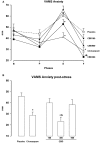Inverted U-Shaped Dose-Response Curve of the Anxiolytic Effect of Cannabidiol during Public Speaking in Real Life
- PMID: 28553229
- PMCID: PMC5425583
- DOI: 10.3389/fphar.2017.00259
Inverted U-Shaped Dose-Response Curve of the Anxiolytic Effect of Cannabidiol during Public Speaking in Real Life
Abstract
The purpose of this study was to investigate whether the anxiolytic effect of cannabidiol (CBD) in humans follows the same pattern of an inverted U-shaped dose-effect curve observed in many animal studies. Sixty healthy subjects of both sexes aged between 18 and 35 years were randomly assigned to five groups that received placebo, clonazepam (1 mg), and CBD (100, 300, and 900 mg). The subjects were underwent a test of public speaking in a real situation (TPSRS) where each subject had to speak in front of a group formed by the remaining participants. Each subject completed the anxiety and sedation factors of the Visual Analog Mood Scale and had their blood pressure and heart rate recorded. These measures were obtained in five experimental sessions with 12 volunteers each. Each session had four steps at the following times (minutes) after administration of the drug/placebo, as time 0: -5 (baseline), 80 (pre-test), 153 (speech), and 216 (post-speech). Repeated-measures analyses of variance showed that the TPSRS increased the subjective measures of anxiety, heart rate, and blood pressure. Student-Newman-Keuls test comparisons among the groups in each phase showed significant attenuation in anxiety scores relative to the placebo group in the group treated with clonazepam during the speech phase, and in the clonazepam and CBD 300 mg groups in the post-speech phase. Clonazepam was more sedative than CBD 300 and 900 mg and induced a smaller increase in systolic and diastolic blood pressure than CBD 300 mg. The results confirmed that the acute administration of CBD induced anxiolytic effects with a dose-dependent inverted U-shaped curve in healthy subjects, since the subjective anxiety measures were reduced with CBD 300 mg, but not with CBD 100 and 900 mg, in the post-speech phase.
Keywords: anxiety; cannabidiol; clonazepam; dose-response; healthy volunteers; public speaking.
Figures


Similar articles
-
Cannabidiol presents an inverted U-shaped dose-response curve in a simulated public speaking test.Braz J Psychiatry. 2019 Jan-Feb;41(1):9-14. doi: 10.1590/1516-4446-2017-0015. Epub 2018 Oct 11. Braz J Psychiatry. 2019. PMID: 30328956 Free PMC article.
-
Effects of acute cannabidiol administration on anxiety and tremors induced by a Simulated Public Speaking Test in patients with Parkinson's disease.J Psychopharmacol. 2020 Feb;34(2):189-196. doi: 10.1177/0269881119895536. Epub 2020 Jan 7. J Psychopharmacol. 2020. PMID: 31909680 Clinical Trial.
-
Cannabidiol reduces the anxiety induced by simulated public speaking in treatment-naïve social phobia patients.Neuropsychopharmacology. 2011 May;36(6):1219-26. doi: 10.1038/npp.2011.6. Epub 2011 Feb 9. Neuropsychopharmacology. 2011. PMID: 21307846 Free PMC article. Clinical Trial.
-
Cannabidiol, a Cannabis sativa constituent, as an anxiolytic drug.Braz J Psychiatry. 2012 Jun;34 Suppl 1:S104-10. doi: 10.1590/s1516-44462012000500008. Braz J Psychiatry. 2012. PMID: 22729452 Review. English, Portuguese.
-
Human experimental anxiety: actual public speaking induces more intense physiological responses than simulated public speaking.Braz J Psychiatry. 2013 Jul-Sep;35(3):248-53. doi: 10.1590/1516-4446-2012-0930. Braz J Psychiatry. 2013. PMID: 24142085 Review.
Cited by
-
Evaluation of Patient Reported Safety and Efficacy of Cannabis From a Survey of Medical Cannabis Patients in Canada.Front Public Health. 2021 May 20;9:626853. doi: 10.3389/fpubh.2021.626853. eCollection 2021. Front Public Health. 2021. PMID: 34095048 Free PMC article.
-
Enhancing Endocannabinoid Control of Stress with Cannabidiol.J Clin Med. 2021 Dec 14;10(24):5852. doi: 10.3390/jcm10245852. J Clin Med. 2021. PMID: 34945148 Free PMC article. Review.
-
Randomized clinical trial of low dose suramin intravenous infusions for treatment of autism spectrum disorder.Ann Gen Psychiatry. 2023 Nov 6;22(1):45. doi: 10.1186/s12991-023-00477-8. Ann Gen Psychiatry. 2023. PMID: 37932739 Free PMC article.
-
New Targeted Treatments for Fragile X Syndrome.Curr Pediatr Rev. 2019;15(4):251-258. doi: 10.2174/1573396315666190625110748. Curr Pediatr Rev. 2019. PMID: 31241016 Free PMC article. Review.
-
Cannabidiol: pharmacology and therapeutic targets.Psychopharmacology (Berl). 2021 Jan;238(1):9-28. doi: 10.1007/s00213-020-05712-8. Epub 2020 Nov 21. Psychopharmacology (Berl). 2021. PMID: 33221931 Free PMC article. Review.
References
-
- Agurell S., Carlsson S., Lindgren J. E., Ohlsson A., Gillespie H., Hollister L. (1981). Interactions of delta 1-tetrahydrocannabinol with cannabinol and cannabidiol following oral administration in man. Assay of cannabinol and cannabidiol by mass fragmentography. Experientia 37 1090–1092. 10.1007/BF02085029 - DOI - PubMed
-
- Agurell S., Halldin M., Lindgren J. E., Ohlsson A., Widman M., Gillespie H., et al. (1986). Pharmacokinetics and metabolism of Δ1-tetrahydrocannabinol and other cannabinoids with emphasis on man. Pharmacol. Rev. 38 21–43. - PubMed
-
- Bergamaschi M. M., Queiroz R. H., Chagas M. H., de Oliveira D. C., De Martinis B. S., Kapczinski F., et al. (2011a). Cannabidiol reduces the anxiety induced by simulated public speaking in treatment-naïve social phobia patients. Neuropsychopharmacology 36 1219–1226. 10.1038/npp.2011.6 - DOI - PMC - PubMed
LinkOut - more resources
Full Text Sources
Other Literature Sources

